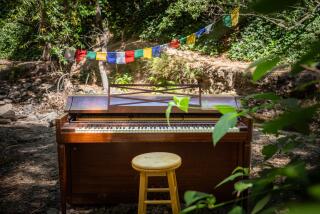Once again, the sound is just grand
- Share via
TALLINN, Estonia — More than 50 years after Josef Stalin set up the Soviet Union’s premier piano plant in this Baltic Sea state, the despot’s favorite pianos are back in red-hot demand -- in the United States.
“I’ve never seen a piano light up the market like the Estonia,” said John Cordogan, owner of the PianoLand store in suburban Chicago, where a glistening Estonia presides center-stage in a showroom otherwise crowded with American and Japanese pianos. “They’re our only product that sells before they even arrive.”
The Estonias are lucky to still exist at all.
After Stalin received an Estonian-made piano as a gift, the iron-fisted ruler established the Estonia Piano Factory and made sure it was the USSR’s sole concert piano supplier.
But when the Soviet Union disintegrated in 1991, so did the factory’s only market. By 1995, production had fallen from 500 pianos a year to 50.
Quality also suffered. Frames cracked; piano wires slipped loose.
That’s when concert pianist Indrek Laul, then 27 and recently graduated from New York’s Juilliard School of Music, offered to buy the plant. Convinced it was a sinking ship, shareholders gladly accepted.
“It was a risk,” recalled Laul, who declined to say how much he paid. “But I did have confidence.”
He also had an entrepreneurial spirit his predecessors lacked, and he quickly concluded that the only option was to go West.
To appeal to American tastes, he gave the pianos shinier finishes and started making them not only in black but in mahogany, walnut and reddish-brown African bubinga.
The factory continued to use Siberian spruce for soundboards -- the heart and soul of pianos. But Laul promptly altered much of the design.
American specialists were brought in. Some changes suggested in the morning were made by afternoon, said Michael Harrison, a New York piano dealer who arranged the consultations.
During a tour of the labyrinthine factory, Laul shoved a stool under one of the handmade pianos and played Liszt’s Nocturne No. 3 to demonstrate the product.
“I’d compare the sound, well, to a fine Merlot wine -- warmer and richer than other pianos,” said Laul, now 36.
Industry analysts praised the upgrades.
“Ten years ago, the Estonias had merit but something wasn’t quite right about them,” said Larry Fine, author of the leading dealers guide, the Piano Book. “Today, everything’s changed for the better. They’re increasingly talked about in the industry.”
Today, 90% of the approximately 500 Estonias handmade each year end up at U.S. dealerships. Estonias account for a fraction of U.S. sales, which were 40,000 grands and baby grands, and 57,000 smaller upright pianos, in 2003, according to Music Trades Magazine.
Estonia makes only grands and baby grands.
“I have customers buying Estonias over Steinways,” Cordogan said. “But I have to fight tooth and nail to get enough of them from the factory.”
A main draw is price.
At $20,000, an Estonia baby grand is half the price of a Steinway, seen as the thoroughbred of pianos. A full-sized Estonia concert grand is $60,000 compared to at least $120,000 for a Steinway.
Labor costs enable the Estonians to keep prices low. Average wages in Estonia are the equivalent of $500 a month -- less than what a U.S. worker might make in a week.
Another edge for the Estonias, analysts say, is Laul himself.
“When you have a concert pianist at the helm, they want to reach the highest levels,” Harrison said. “They’re embarrassed if they can’t.”
Laul, who splits his time between Estonia and a New York office, likens himself to a race car driver who makes his own cars.
“Most pianists have to make the best of the piano they’re on,” he said.
“I can change my piano as I see fit. It’s every pianist’s dream.”
More to Read
The biggest entertainment stories
Get our big stories about Hollywood, film, television, music, arts, culture and more right in your inbox as soon as they publish.
You may occasionally receive promotional content from the Los Angeles Times.









